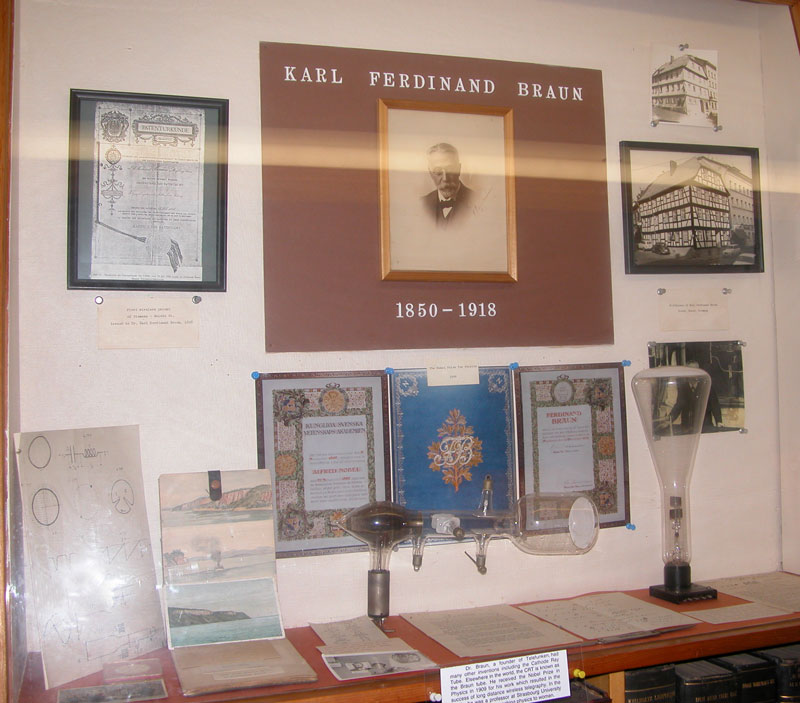Karl Ferdinand Braun was a giant. He died in New York in 1918. He was, as a young man, a professor in Strasbourg University in Alsace, and he had a class of women… this is pioneering in itself… these were physics students and Braun was their teacher.
Anyway, he also invented the cathode ray tube, and this is an original Braun cathode ray tube, which was a gift of Professor Chaffee at Harvard, whom I knew when I was a student there. And that is how he gave it to the museum as a friendly gesture.
In Europe, and most of the rest of the world, up until recently, these were known as Braun Röhres. “Röhre” is the word for “tube” in German. It’s curious that that cathode ray tube, in all its parts, is identical to this Western Electric one, which was built in 1930. That’s a lot of years between them. But, they’re identical in detail. Braun was in New York throughout World War I, and in the days before MIT’s benefactor, George Eastman, of the Kodak Company appeared, many people carried a sketchpad to make a little sketch of where they’ve been as a souvenir of the trip. This is Braun’s sketchpad, and it shows the Palisades of New Jersey on the Hudson River, and the next picture shows Bannerman’s Island, partway up the Hudson River with a steamboat in the middle. And here…Tesla was a friend of Braun’s…and this is a personal note from Tesla to Braun, and it has Tesla’s personal card here.
Braun taught physics and mathematics, and several people…trained mathematicians, have come in and commented that there’s an error on this work. I wish you could copy that, Fred, and analyze it for me and tell me what the mathematical error is! I doubt it.
Fred – “He started an electronics company, right?”
Yes.
Fred – “Was it Telefunken or Blaupunkt?”
Telefunken.
This came from Braun himself…this paper knife.
Fred – “Talk a little about his Nobel Prize.”
Well, he wrote a paper on directional antennas. This is phased-array antennas as far back as 1909, which is very early for that type of science…extremely early. But it’s an erudite paper, and he won the Nobel Prize for this work. The story is, and I have this from his daughter-in-law, who was a good friend of ours…that when Braun, and this gentleman, Marconi, walked up on the stage to receive the Nobel Prize, Braun put his hand out to congratulate Marconi…of course they got the prize for different subjects…they weren’t competing on the stage…Marconi absolutely snubbed Braun, and wouldn’t even speak to him…which reflects exactly what kind of a snob he was. Of course, he was of minor nobility because his mother was a Jameson, and he had an entrée in all society in London for that reason.
I think Marconi was critical of Telefunken barging into Marconi’s business. Telefunken also made superior equipment, far better than Marconi’s stuff.
Fred – “Because it was more science-based.”
Absolutely.
The reason we have this wonderful collection of Karl Ferdinand Braun things is that Jackie Braun, who is this lady in this picture, lived in Kingston, Rhode Island, and her husband was Karl Ferdinand Braun’s son.
Text from the transcript of a tour of New England Wireless & Steam Museum’s Wireless Building given by Robert W. Merriam on a winter day in 2012. Transcription by Craig H. Moody, K1CHM. Edited by Fred Jaggi.
